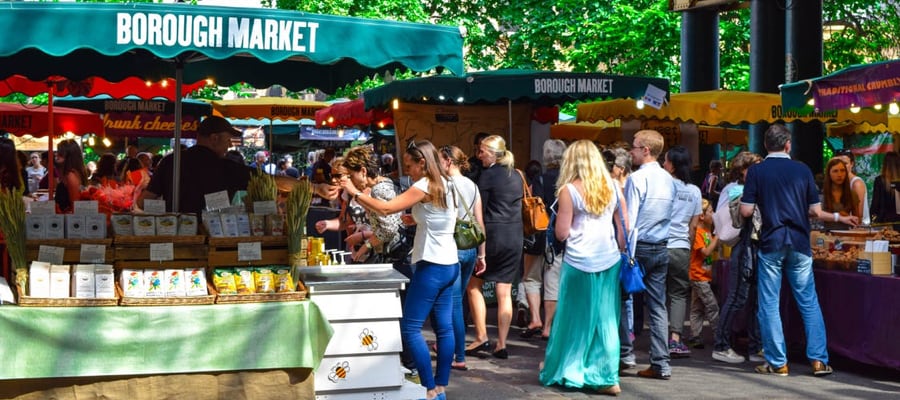Every Thursday outside the local library, there’s a farmer’s market. About a dozen farms come to participate and sell all manner of fruit, spices, vegetables, cookies, pies, bread, and almost anything else you can think of. It’s really a delight to walk over, chat with the proprietors, and pick up some produce (and some pies) on the cheap. Farmer’s markets are a great way to save money, support your local businesses, and help out the environment all at once. Here are four reasons why we shop at our local farmer’s market.
The Reasons
Supporting Local Business
If you want to complain about Wal-Mart closing down Mom and Pop shops, you’re the perfect candidate to shop at your local farmer’s market. Supermarkets have been shutting down local farms for years, so supporting local farmer’s markets is the best way for you to support your local farms.
Local businesses also have a vested interest in the improvement of the community. Sure the corporations care a little bit about the neighborhoods they’re in, but it’s not on the same level as actually local business owners who live and breathe their livelihood in the area.
Better Buying Experience
At the market, it’s often the owner’s family running the stands. It’s a lot of fun to chat with them about what they do, about the farm, and learn more about the things sitting on the table. You’ll find out whether the strawberries you’re buying are too tart for straight eating and would do better in a pie. You’ll learn how to tell if something is ripe or whether you should let it sit for a little bit. Those aren’t things you can get from the disinterested employee stocking shelves at the supermarket.
Conserve Fuel
You personally save fuel by visiting a local market instead of the supermarket, especially in my case where I’m able to walk to the store, but the bigger picture fuel savings is in the transportation of the produce. Since fuel prices have been so low for so long, we got used to buying out of season fruits and vegetables because we could important them from places where they were in season. Now that prices have substantially increased, we’re finding out of season produce to be much more expensive than they used to be, which can be a good thing. By buying local, you ensure you’re getting something that was produced relatively close by and thus has cost less fuel to get to your table.
It’s not 100% though, sometimes the farmer’s market vendors branch out so they can provide more of a one-stop-shop experience. Usually, they’re selling all their own stuff though.
Saving Money
The local Giant Food supermarket and the farmer’s market are within walking distance so one day I did a price comparison. In every single case, the fruit and vegetables at the farmer’s market were cheaper. Squash, zucchini, roma and beefsteak tomatoes, green peppers, radishes, garlic, plums, apples, strawberries, and few others were all cheaper. The supermarket had a wider selection (no one at the farmer’s market last week had orange, yellow, or red peppers) of course but the prices were all several cents higher per pound.
I was actually surprised by this. When you look at Kona coffee, produced with American labor being paid at least minimum wage, you’re paying around $20-30 per pound. When you look at Colombian coffee, produced with non-American labor not being paid minimum wage, you can find prices under $10 a pound. The disparity is amazing in that market. I would expect that the same market forces govern the produce industry but I suspect that local farmers are simply taking in less than the minimum wage for their work, which is even more reason to support them.
Finding Farmer’s Markets
So, you’re sold on farmer’s markets, how do you find them? I would check with your state’s Department of Agriculture or simply relying on Google (search for “farmer’s market + state”). In New York, the Department of Agriculture has a list of the state’s farmer’s markets so you’ll want to look for something similar in your state.
Tips for Shopping
Here are five of my best tips on shopping at a farmer’s market:
1. Check the size of the market first
The market by us is a decent size for our area with a good mix of produce, baked goods, and jams. Some markets would make our dozen vendors look tiny, especially markets out on the west coast, and so it’s good to get an idea of how big the market normally is. If it’s too small, it might not be beneficial for you to go.
2. Bring reusable shopping bags or just regular bags
It’s good to be eco-friendly but introducing another plastic bag into the wild is a bit counter productive! I just bring a backpack and throw my stuff in there.
3. Bring small bills
You probably won’t be spending a ton of money at any one stand and having the vendor break a $20 for a $2 purchase can put a damper on their change situation.
4. Talk to them
Ask them about the fruit, ask them about good ways to prepare them. They love talking about it because it’s their life and their baby plus they can give you wonderful ideas.
5. Save your containers
Sometimes the fruit comes in little cardboard containers so we’ll save those to bring back and return to the vendor. We don’t get anything for it but it’s better to reuse something than it is to recycle or toss it.
If you have any more tips or any good reasons I missed, please let me know. I’ll be heading over to the market this evening! We’re going to pick up some squash and zucchini and get together the stuff we’ll need for a little zucchini bake.
